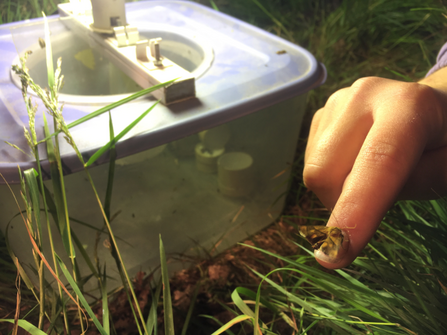Another week of #30dayswild and lots of lovely random acts of wildness. Remember you can still sign up and get lots of tips and ideas through the Wildlife Trust’s electronic packs, here.
Week 3 of 30 Days - chatting around the moth trap, owls and some mysterious beetles
Stag beetle - Ali North
Day 15 – myself and Wild Learning Officer Lucy were running our first ‘Wet your Whistle with Wildlife’ event in Christchurch park and we saw lots of awesome nocturnal species. First up we checked our footprint tunnels for signs of hedgehogs and other small critters. Unfortunately no hogs, but we did find lots of rodent prints before pipistrelle bats started whizzing up and around our heads, a large male stag beetle zoomed up and above the trees and we watched a lovely fox using our night vision monocular! You can book onto our next Wet your Whistle with Wildlife event, here.

Ali North
Day 16 – June has certainly been a month for night walks and for day 16 myself, Greenways and Urban Buzz were running a night safari in Chantry Park. Off we went in search of Daubenton bats around the lake , wandered around the meadow watching pipistrelles, more stag beetles, a beautiful elephant hawk moth and some rabbits! We ended the evening chatting around the moth trap, eating biscuits and sipping on hot drinks, as we identified the moths and other flying insects fluttering around us. Perfect!
Day 17 – a stroll along the river Deben, some tree clambering and the discovery of lots of shore crabs!
Day 18 – the hunt for Ipswich glow worms continued and tonight, we were successful! Twelve beautiful glow worms were found, declaring their presence with their very bright LED like lights shining through the grass and bracken. Whilst called worms, glow worms are of course actually beetles and it is the female glow worms that are lit up here, trying to attract the flying males for mating. They will often glow for the first few hours of darkness, but will stop glowing upon mating. I submitted our sightings to the UK glow worm survey, here. They could well be in more places than we realise. Keen an eye out for them on your night time wanderings, and do submit your sightings!
Day 19- A little while ago I google earthed my neighborhood to look at how my street fitted into the wider landscape and where my local hedgehog population might be foraging and nesting. I wandered to one of my nearest patches this evening and checked out some great foraging and nesting habitat. I’ll be surveying this patch soon to see if I can record signs of hedgehogs! Why not have a look at your street and work out how it could be made better linked into your local green spaces?
Day 20 – A lovely kayak under a rookery, chasing a kingfisher and paddling under a beautiful evening sky!
Day 21 – a new perceptive for my office commute. It’s amazing what you notice when you cycle a route you usually drive.
Day 22 – an evening stroll along quiet lanes along the edge of Ipswich in search of Little Owls, with success! Two owls and an owlet! In and out of a big old oak they flew, perching on fence posts and making contact calls between them. Breeding bird survey data suggests these owl numbers are declining – the Little Owl Project aims to better understand the ecology of the Little Owl, and help better conserve this beautiful species! Please do submit any Little Owl sightings you have to help better understand their distribution and target future action. If you look very closely you might be able to spot one of the owls poking its head out of the oak, below!
Day 23 – Catching up with some London friends in Regent’s Park! I’ve been reading about this park recently as it is home to the last remaining breeding population of hedgehogs in a London centre park. There is a brilliant project monitoring the population, hedgehog spatial use of the park, the threats they face, habitat use and working with the parks land managers to help limit threats and improve habitat for the population. It is a collaboration between The Royal Parks, The Zoological Society of London (ZSL), Garden Wildlife Health Project (GWH), the Central Royal Parks Wildlife Group, scientists Dr Nigel Reeve, Professor John Gurnell and LOTS of volunteers; you can read about the project, here.





